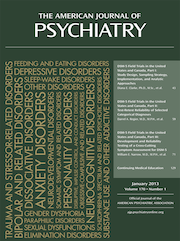DSM-5 Field Trials in the United States and Canada, Part II: Test-Retest Reliability of Selected Categorical Diagnoses
Abstract
Objective
The DSM-5 Field Trials were designed to obtain precise (standard error <0.1) estimates of the intraclass kappa as a measure of the degree to which two clinicians could independently agree on the presence or absence of selected DSM-5 diagnoses when the same patient was interviewed on separate occasions, in clinical settings, and evaluated with usual clinical interview methods.
Method
Eleven academic centers in the United States and Canada were selected, and each was assigned several target diagnoses frequently treated in that setting. Consecutive patients visiting a site during the study were screened and stratified on the basis of DSM-IV diagnoses or symptomatic presentations. Patients were randomly assigned to two clinicians for a diagnostic interview; clinicians were blind to any previous diagnosis. All data were entered directly via an Internet-based software system to a secure central server. Detailed research design and statistical methods are presented in an accompanying article.
Results
There were a total of 15 adult and eight child/adolescent diagnoses for which adequate sample sizes were obtained to report adequately precise estimates of the intraclass kappa. Overall, five diagnoses were in the very good range (kappa=0.60–0.79), nine in the good range (kappa=0.40–0.59), six in the questionable range (kappa=0.20–0.39), and three in the unacceptable range (kappa values <0.20). Eight diagnoses had insufficient sample sizes to generate precise kappa estimates at any site.
Conclusions
Most diagnoses adequately tested had good to very good reliability with these representative clinical populations assessed with usual clinical interview methods. Some diagnoses that were revised to encompass a broader spectrum of symptom expression or had a more dimensional approach tested in the good to very good range.



